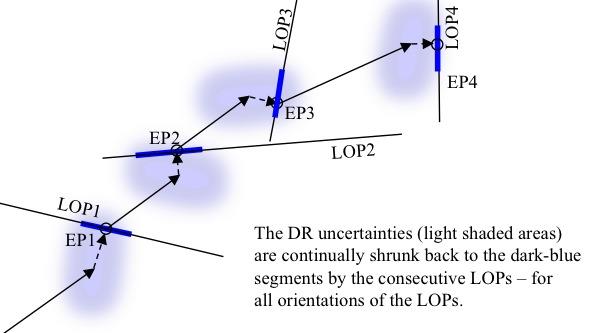
NavList:
A Community Devoted to the Preservation and Practice of Celestial Navigation and Other Methods of Traditional Wayfinding
From: John Karl
Date: 2010 Oct 26, 14:03 -0700
Yes Garry, I agree (Post 14211). The traditional running fix (TRF) should be used where the DR is more accurate than the LOP, such as the star fix I mentioned. And the EP running fix (EPRF) should be used where the opposite is true, such as a DR run of many hours followed with an accurate LOP. And in between science meets art.
The first attachment below shows the dead reckoning propagation of uncertainty from EP1 to DR1 under the conditions for the EPRF. Without any further information, the best position estimate is at EP2 because the product of the probability along LOP2 (dark blue) with the probability distribution (light blue) centered on DR1 is maximum there. In the short-run case the dark-blue uncertainties would extend all along both the advanced LOP1 and along LOP2, putting the fix at RFIX, just as you said.
In the intermediate case, shown in the second attachment, these areas of uncertainty overlap, requiring a knowledge of the probability distribution of each area to make a detailed decision. The crudest conclusion is that we’re probably not outside the region of common overlap. And in fact, according to the old navigator’s saw, that’s all we need to know: not where we are, but where we are not. To get a quantitative answer, we’d actually have to know the distributions. For LOP2, most celestial navigators have a good idea of their personal accuracy. But the area around DR1 is more difficult – what is the worst case of unknown currents? How well did that helmsmen do overnight? etc. It’s hard to envision a case where the navigator would know the details of the error distribution around DR1. But if we did know that, say two Gaussians (bell-shaped curves) with known widths (2-dimensional around DR1), we could solve for the most probable location (or locations).
This is why I call the AF manual naïve. They can’t know the most probable location without a knowledge of these distributions. Plus, as I observed, their formula in dimensionally incorrect, making it impossible to understand. (The formula gives the correct result for the long-run fix, at t = infinity. But it doesn't make sense at t=0)
Lastly, I can’t resist attaching a third diagram showing how a sequence of EPRFs continually limits the EP uncertainty, regardless of the relative LOP orientations -- any newly acquired LOP must improve the estimated position.
JK
----------------------------------------------------------------
NavList message boards and member settings: www.fer3.com/NavList
Members may optionally receive posts by email.
To cancel email delivery, send a message to NoMail[at]fer3.com
----------------------------------------------------------------









